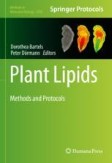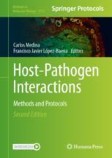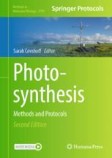Search
Search Results
-
Detection of Mycolactone by Thin Layer Chromatography
By means of thin layer chromatography coupled to a fluorescence enhancer, a highly sensitive and operationally simple method to detect the...
-
Thin-Layer Chromatography
Lipid extracts from plants represent a mixture of polar membrane lipids and nonpolar lipids. The main constituents of the polar lipid fraction are...
-
Two-Dimensional Thin Layer Chromatography of Melatonin and Related Compounds
Two-dimensional thin layer chromatography has been used by workers in the field to separate radiolabeled serotonin derivatives from complex mixtures...
-
Chromatography
This chapter covers the principle, working, and operations of different types of chromatographic techniques like paper, thin layer, column...
-
Chemical and cytotoxicity profiles of 11 pink pepper (Schinus spp.) samples via non-targeted hyphenated high-performance thin-layer chromatography
IntroductionPink pepper is a worldwide used spice that corresponds to the berries of two species, Schinus terebinthifolia Raddi or S. molle L....

-
Analysis of Phosphoinositides from Complex Plant Samples by Solid-Phase Adsorption Chromatography and Subsequent Quantification via Thin-Layer and Gas Chromatography
The determination of phosphoinositide molecular species in plant material is challenging because of their low abundance concurrent with a very high...
-
Generating an EMS Mutant Population and Rapid Mutant Screening by Thin-Layer Chromatography Enables the Studies of Monoterpenoid Indole Alkaloids Biosynthesis in Catharanthus Roseus
Decades of research on the medicinal plant Catharanthus roseus have led to the complete elucidation of the 29-step pathway for the biosynthesis of...
-
Detection of Pyoluteorin by Thin Layer Chromatography
Pyoluteorin, an aromatic phenolic polyketide antibiotic is capable of suppression of broad spectrum of plant pathogens. It was first isolated from...
-
Extraction and Characterization of Siderophore [Catecholate Type] by Thin Layer Chromatography
The estimation of catecholate type of siderophore was performed (Jadhav and Desai, Curr Microbiol 24:137–141, 1992), following the protocol...
-
Comparative phytochemical screening through high-performance thin layer chromatography technique and free radical scavenging ability of five species of genus Clerodendrum
Species of Clerodendrum are a well-known medicinal plant in the Indian traditional system of medicines for its multi-purpose use in the management of...

-
Bacterial Enzyme Assay for Mucin Glycan Degradation
Bacterial sialidase and sulfoglycosidase may act on the acidic modifications of mucin O-glycans, producing sialic acid and 6-sulfated...
-
Lipid Analysis by Gas Chromatography and Gas Chromatography–Mass Spectrometry
Gas chromatography (GC) and gas chromatography–mass spectrometry (GC-MS) represent powerful tools for the quantitative and structural analysis of...
-
Nod Factor Lipopolysaccharide Purification to Study Nitrogen-Fixing Bacteria Symbiosis with Legumes
Nod factors (NF) are lipochitooligosaccharides produced by nitrogen-fixing rhizobia bacteria. They are key components of the rhizobia-plant signaling...
-
Evaluation of Lipids for the Study of Photosynthetic Membranes
The biological role of lipids goes far beyond the formation of a structural membrane bilayer platform for membrane proteins and controlling fluxes...
-
High-Performance Chromatographic Separation of Cerebrosides
High-performance thin layer chromatography (HPTLC) is a very robust, fast, and inexpensive technique that enables separation of complex mixtures....
-
Radiometric Assay of NAPE-PLD Activity
N-Acyl-phosphatidylethanolamine (NAPE)-hydrolyzing phospholipase D (NAPE-PLD) is a prominent enzyme involved in the biosynthesis of fatty acid...
-
The Detection of Toxic Compounds in Extracts of Callilepis laureola (Oxeye Daisy) and Senecio latifolius (Ragwort) by Ultra-Performance Liquid Chromatography-Mass Spectrometry (UPLC-MS/MS)
Methods used for the detection of toxic components of Callilepis laureola and Senecio latifolius have ranged from the use of thin-layer...
-
Analysis of Capsaicin and Related Compounds by Modern Chromatographic Methods
Capsaicin is a major bioactive of chilli pepper, belonging to the genus Capsicum (family Solanaceae). It is the most pungent compound of hot peppers...
-
Monitoring of catechin content by high performance liquid chromatography during the development of seed and pods of Saraca asoca (Roxb.) De Willd
Saraca asoca (Roxb.) Willd, is an indigenous medicinal plant of family Caesalpiniaceae. Different parts of this plant including seeds and pods,...

-
Assay of NAAA Activity
N-acylethanolamine-hydrolyzing acid amidase (NAAA) is a lysosomal hydrolase degrading various N-acylethanolamines at acidic pH. NAAA prefers...
